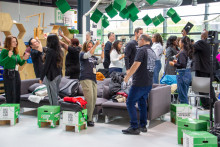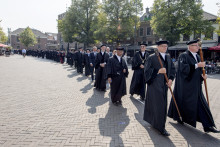This was the first online lecture the DesignLab hosted during crisis time. The online format turned out very different to a standard lecture, as it misses out on the whole subtle nuances in human interaction. The catching of eyes between the speaker and the crowd, the laughter once a joke is made. And of course the perfect audiowave connection as nothing gets lost in transmission.
Alumnus Jonathan Bennink shared his story with the online audience. After his master's thesis, he was working on designing customized measurement and control systems for liquid and gases. At some point, the project was growing at a pace that got too stressful. Which is when he decided to quit and take a half year break. In these six months, he decided that he wanted to work for LEGO but did not apply for a job. Instead, he started a project for LEGO without their knowledge.
‘My family thought I was crazy’
After conducting a lot of research on play he concluded that there was a profound need for an online, creative platform for games. Therefore, he designed a smart bottom plate for LEGO structures that could recognise which block was placed on it. The working prototype had features like lit structures and rotating windmills that could be actuated upon touch. ‘My family thought I had gone crazy since the only thing I was doing was intensely playing with blocks without any certainty of a job,’ said Bennink.
He then purchased LinkedIn Gold to get in touch with LEGO’s CEO and managed to arrange a meeting where he presented his working prototype and idea. ‘I did not patent the idea, even though I had a working prototype. Again, my family thought I was crazy. However, the only thing I wanted to do, was to show LEGO what I could do with their product.’
Life lessons
Luckily for Bennink, LEGO liked the idea and hired him to work for them in Denmark. One of his next projects was to work on a collaborative project with LEGO and Nintendo which is where, after many design iterations, LEGO Super Mario was born. This project was a huge learning experience for Johnathan, as there were plenty of iterations that the company was not entirely satisfied with which made the design team scrap the idea and start at zero again. The whole experience taught him the following lessons, which he shared with his online audience yesterday.
Life lessons from Jonathan
#1) It’s not the idea that matters, it’s how you execute it.
#2) Find out what your brand / company DNA is and stick to it … 100%
#3) It’s simple to make something complex, but it’s complex to make something simple.
#4) Money talks but luckily, experiences live in low-fi.
#5) People don’t buy technology, they buy a feeling or an experience.
At the end, he mentioned two things that helped him in his career. First, the basic fundamentals of the design process that he learned during his study were on point, said Bennink. They were the foundations that he needed in his job and he was well equipped. ‘My time at the UT has influenced where I am now and how I look at things,’ he shared. Second, the entrepreneurial spirit on campus gave him confidence in ‘getting out there and try new things’, and he concluded: ‘the world does not wait for you, you have to get out there and do it.’







